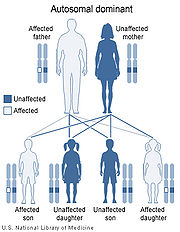
Metachondromatosis
Encyclopedia
Metachondromatosis is an autosomal
dominant skeletal disorder affecting the growth of bone
s, leading to multiple enchondromas and osteochondromas. Affects mainly tubular bones, though can involve the vertebrae.
 Metachondromatosis is inherited in an autosomal dominant manner. This means that the defective gene responsible for a disorder is located on an autosome
Metachondromatosis is inherited in an autosomal dominant manner. This means that the defective gene responsible for a disorder is located on an autosome
, and only one copy of the gene is sufficient to cause the disorder, when inherited from a parent who has the disorder.
It has been associated with PTPN11
.
Autosome
An autosome is a chromosome that is not a sex chromosome, or allosome; that is to say, there is an equal number of copies of the chromosome in males and females. For example, in humans, there are 22 pairs of autosomes. In addition to autosomes, there are sex chromosomes, to be specific: X and Y...
dominant skeletal disorder affecting the growth of bone
Bone
Bones are rigid organs that constitute part of the endoskeleton of vertebrates. They support, and protect the various organs of the body, produce red and white blood cells and store minerals. Bone tissue is a type of dense connective tissue...
s, leading to multiple enchondromas and osteochondromas. Affects mainly tubular bones, though can involve the vertebrae.
Genetics

Autosome
An autosome is a chromosome that is not a sex chromosome, or allosome; that is to say, there is an equal number of copies of the chromosome in males and females. For example, in humans, there are 22 pairs of autosomes. In addition to autosomes, there are sex chromosomes, to be specific: X and Y...
, and only one copy of the gene is sufficient to cause the disorder, when inherited from a parent who has the disorder.
It has been associated with PTPN11
PTPN11
Tyrosine-protein phosphatase non-receptor type 11 also known as protein-tyrosine phosphatase 1D or protein-tyrosine phosphatase 2C is an enzyme that in humans is encoded by the PTPN11 gene. PTPN11 is a protein tyrosine phosphatase Shp2.PTPN11 is a member of the protein tyrosine phosphatase ...
.

